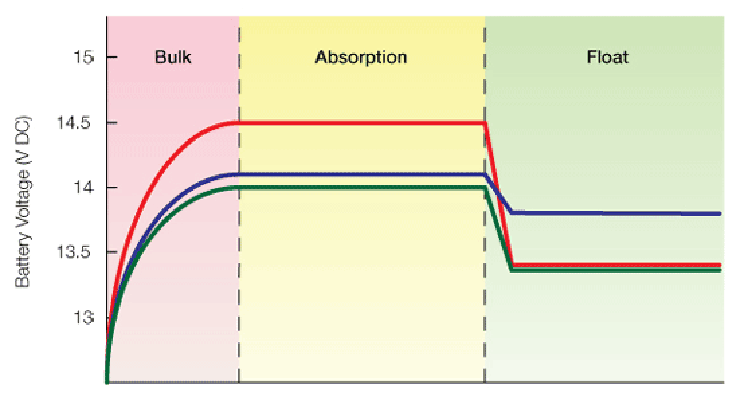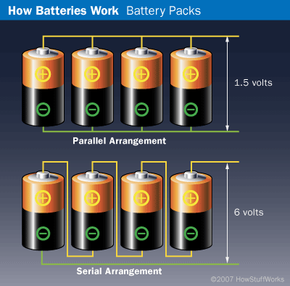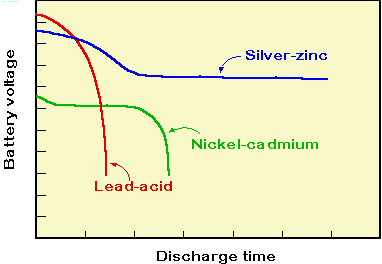How Do Batteries Produce a Voltage Difference in a Circuit
Make sure your charger is set to the correct battery type either AGM or. Tape the paperclip in place with a narrow piece of tape do not tape over the metal battery ends.

Connecting Batteries In Series Batteryguy Com Knowledge Base
The difference between the two E 0 values tells you your cell s electrochemical potential which is basically the voltage of the cell.

. Now you can connect one wire to each paper. It does notify the potential energy stored as electrical charge in an electrical supply point. Batteries power supplies or solar cells produce a DC.
Voltage is the other important measurement marked on batteries. A voltage divider uses two resistors to take an input voltage V 1 in Figure 6 and reduce or divide it by a certain amount. Turn the batteries over and tape one end of a paper clip onto each of the batteries.
An electric power system is a network of electrical components deployed to supply transfer and use electric power. The electrical grid can be broadly divided into the generators that supply the power the transmission system that carries the power from the. The best way to test the voltage of both AGM and LiFePO4 batteries is to take 5 readings.
Therefore it requires an external source to work and operate in a circuit. Circuit must have adjustable voltage regulator so Variable voltage regulator LM317 is selected. How do chargers detect the end of the charging cycle.
So if you take lithium and fluoride and manage to combine them to make a battery cell you will have the highest voltage theoretically attainable for an electrochemical cell. These batteries only work in one direction transforming chemical energy to electrical energy. Voltage is the potential difference between two points of a circuit.
The VOC should be 168 to 216. This is because if we connect a Diode in a circuit which is further connected to the supply voltage the diode will not conduct the current either in forward or reverse bias until the level of voltage reaches to 03V In case of Germanium or 07V In case of Silicon. An example of a power system is the electrical grid that provides power to homes and industries within an extended area.
The power something like a lamp or electric motor produces or consumes is proportional to. The reactions of the anode and cathode materials in NiMH batteries produce approximately 12 volts. Direct current voltage source of a fixed value and polarity.
When a voltage source is connected to a closed loop circuit the. The output voltage V 2 depends on the values of the two resistors. The difference between two points called as potential difference or voltage drop.
Lithium-ion batteries are getting better all the time as electric cars clearly demonstrate. For instance energy can be stored in Zn or Li which are high-energy metals because they are not stabilized by d-electron bonding unlike transition. The hardware thats bringing computing everywhere.
The higher the voltage the more current a battery will produce when its connected into a given circuit which is why this kind of voltage is sometimes called an electromotive force EMF. Set a paperclip across the batteries so that it connects the end of one to the - end of the other. For example alkaline batteries have a voltage of approximately 15 volts due to the reaction between the anode and cathode materials.
Lightweight lithium-ion batteries were first properly used in electric cars in. The VMPP maximum power voltage of the solar panel or array has to be 13 times more than the battery nominal voltage. In this circuit those resistances depend on how much light is.
The batterys polarity 1 and 4 - is trying to push the current through the loop clockwise from 1 to 2 to 3 to 4 and back to 1 again. Voltage or potential difference is the measure of potential energy between two points in a circuit and is commonly referred to as its volt drop. Compared to heavy-duty rechargeable batteries such as the lead-acid ones used to start cars lithium-ion batteries are relatively light for the amount of energy they store.
The first thing you are going to need to do is fully charge the battery with either a charger or solar panels. The potentiometer is combined with the photoresistor to form a voltage divider. We can denote or measure the voltage difference between any two points in circuit nodes junction etc.
Here LM317 can produce a voltage from 125 to 37 volts maximum and maximum current of 15 Amps. This means you will need a pen and paper to average the readings out. Adjustable Voltage regulator has typical voltage drop of 2 V-25V So Solar panel is selected such that it has more voltage than the load.
Batteries convert chemical energy directly to electrical energyIn many cases the electrical energy released is the difference in the cohesive or bond energies of the metals oxides or molecules undergoing the electrochemical reaction. The VOC voltage open circuit of your solar panel must be 14 to 18 times greater than the battery nominal voltage. If the battery is disposable it will produce electricity until it runs out of reactants same chemical potential on both electrodes.
With the circuits continuity broken between points 2 and 3 the polarity of the voltage dropped between points 2 and 3 is for point 2 and - for point 3.

Battery Arrangement And Power Howstuffworks

Basics Of Battery Charging Circuit Design Battery Power Tips


No comments for "How Do Batteries Produce a Voltage Difference in a Circuit"
Post a Comment